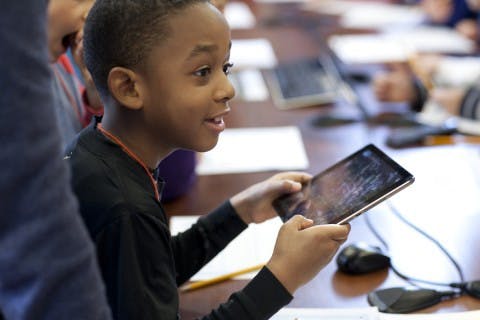2nd Graders Build up STEAM at Modus

For most of my career, I have been a database architect. I love data and the data sciences. Analyzing patterns, forecasting, moving and streaming data, and designing databases — that’s my thing. I find it to be an extremely creative mental space. I’ve also been lucky enough to be surrounded by engineers and designers that are all forms of crazy.
But despite all that, there just aren’t very many female engineers, particularly those who are American born. And from my purview, young girls and women stand down or opt-out — even when they have the skills and/or social support to hold their own in engineering arenas. It’s maddening.
So, as you may have imagined, I’ve been intently following a couple of important initiatives that center on closing the gender gap: Girls Who Code and Lean In. Girls Who Code focuses on equipping girls with the skills needed to succeed in technology and engineering fields; Lean In focuses on leveling the playing field for women through education, awareness, and encouraging them to take a seat at the table.
These initiatives recently inspired me to take up a request from my daughter’s teachers to host a field trip to a parent’s workplace. So on April 23, 2015, I made a bold move and brought my daughter’s entire 2nd-grade class into the Modus office. It was Take Our Daughters and Sons to Work Day, but that was simply serendipitous. My goal was to draw the kids into a fun STEAM (Science, Technology, Engineering, Art/Design, and Mathematics) project — and hopefully encourage lasting interest in these fields among the students, regardless of gender.

Resources for Little Coders
Leading up to this event I experimented with many different projects and tools to find the right fit. I was primarily interested in building a video game, but I was delighted to learn just how many resources are available for students to learn to code. Here are a few of my favorites:
- Code.org
- Code-To-Learn Foundation
- Scratch by MIT Media Lab
- CodeDojo
- Hour of Code
I chose Pixel Press Floors, which was a perfect fit for our company, a digital design agency. Pixel Press offered a student curriculum that demonstrates a design thinking process through game development.
One version of the design thinking process has five simple stages: empathize, define, ideate, prototype, and test. This approach embodies much of what we do at Modus every day — and gave me a methodology to engage 22 2nd graders!
Let the Modus Game Jam Begin
With a nod and a wink to the world’s largest game creation event Global Game Jam and Pixel Press, I started off by enlisting help. I rounded up 10 iPads, three engineers, two artists, and one tester to assist the kids and take pictures. Given that our audience was 7 and 8-year-olds, we adopted a simple objective and process — and kept explanations to a minimum so we could jump right in.

Our goal was to build a video game in under an hour. Here’s how we approached it:
To begin, we drew the kids in by asking what games they like to play and why. We asked them what kind of problems or challenges they needed to solve and what the reward was for solving those problems (e.g., points, power-ups, winning). Most of the kids didn’t realize they were solving problems, so we gave examples like, “Do you need to keep your character alive?” Or, “Do you need to get to home base without getting hit with a ball?” Every child had a favorite game and was excited to share.
After that, we jumped right in and handed out pixel graph paper and pencils. The trick to Pixel Press Floors is to translate symbols to objects, so we gave the kids a few symbols to work with and got down to business drawing our video games. We created terrain, collectibles, hazards, and helpers. Just as soon as everyone had drafted the first floor of their new game, we started scanning and rendering our games.
At this point, the kids could test their games and this is where we were able to ask questions, make suggestions, and explore. Many kids went back to their drafted video game on the pixel paper and revised their work after they saw how the symbols actually translated, which was exactly what we wanted. In fact, the teachers compared this game-oriented development process to the steps they are encouraged to follow when writing (e.g., brainstorm, draft, review, edit, and revise). I loved the analogy.

In the end, the kids loved it and many of them continued to build games after they got home. They told me it was the “best field trip ever,” which is quite possibly the highest compliment a kid can pay an adult as far as I’m concerned.
While we may not have totally succeeded in teaching the principle of design thinking, another day and another hour might have made that possible. Regardless, it was a huge success. My daughter was unbelievably proud of me, my leadership, and my company. And maybe, just maybe, this was the beginning of a lifelong interest in software design and development for these students.
Many thanks to Modus for sponsoring this event and to PS 372 The Children’s School, a remarkable public school in Brooklyn dedicated to teaching children with a wide range of abilities and disabilities in an integrated co-teaching setting. Last but not least, this event could not have happened without the help of David Bebawy, Kate Baldwin, Kate Diago, Miro Samawil, Steve Yacoub, and William Ellis. We nailed this, let's do it again!


